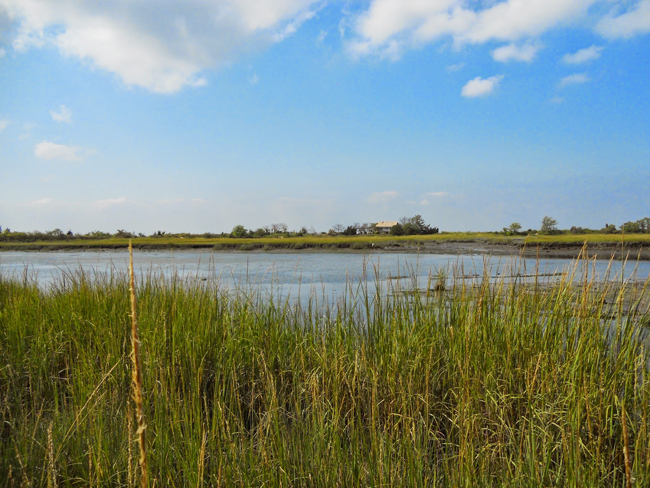
Long Island Sound's western basin is just north of Frost Creek in Lattingtown, NY. Credit: Amy Mandelbaum, NYSG/LISS
— By Chris Gonzales, Freelance Science Writer, New York Sea Grant
A group of scientists funded by the Long Island Sound Study Research Grant Program—a partnership program of the EPA Long Island Sound Office and the Connecticut and New York Sea Grant Programs—are assembling the pieces of a puzzle to determine the impact of past excesses in nitrogen release to Long Island Sound and the efficacy of efforts to remediate them.
A Delicate But Resilient System
Stony Brook, NY, March 11, 2022 - It’s an unfortunate fact: for too long, humans have been releasing too much nitrogen into one of the U.S. East Coast’s largest estuaries—Long Island Sound (LIS). Nitrogen, a component of fertilizer runoff, wastewater treatment discharges, and septic system seepage, upsets the delicate chemistry on which all life in the wider region depends.
So far in this, the 21st century, considerable expense and effort has been made to remediate conditions by reducing the amount of nitrogen inputs, especially from sewage and wastewater treatment plants (WWTPs).
A group of scientists funded by New York Sea Grant and Connecticut Sea Grant are assembling the pieces of a puzzle to determine the impact of past excesses in nitrogen release to LIS and the efficacy of efforts to remediate them.
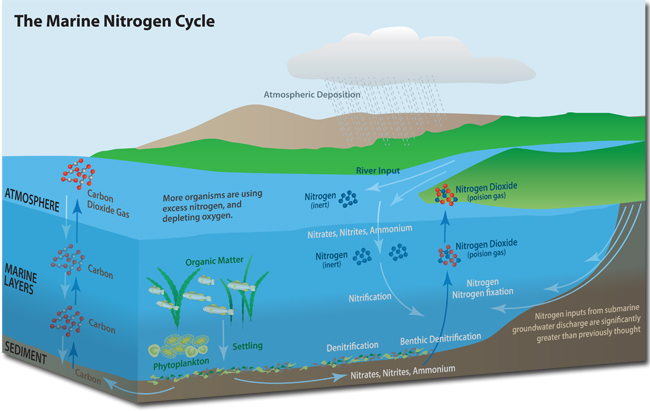
The marine nitrogen cycle. Credit: Loriann Cody
In a series of studies, they’re helping us better understand the quantities of nitrogen currently present in the Sound, as well as how it is transferred around, and how it may be changing into the future. The researchers responsible for these studies have developed advanced approaches like the use of both nitrogen and oxygen isotopes to monitor the health of the Sound's waters. Innovations like these, by improving our understanding, also protect the environment.
However, patience is needed, as it will take a long time for LIS to recover, even after recent reductions in nitrogen inputs. Furthermore, we need to be persistent, and continue to reduce nitrogen inputs into the Sound, or else the expected stressors of climate change could continue to lead to additional water quality challenges.
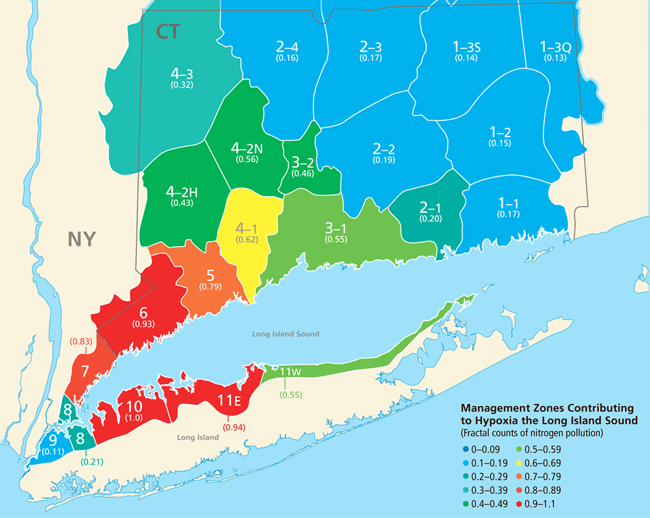
This map shows priority zones for managing nitrogen in the Long Island Sound. Credit: Long Island Sound Study/UConn
Isotope Monitoring
Long Island Sound is an estuary, a coastal region where fresh water drains from rivers and land and mixes with salt water from the ocean. It is situated between Connecticut to the north, and Long Island to the south, and stretches approximately 110 miles from the East River in New York to the west to Block Island Sound to the east. The Sound is well developed as a transportation hub, as well as for commercial and recreational fishing. The entire watershed that feeds into the Sound has a human population of almost 9 million, according to the 2010 census. This is primarily because the Connecticut River draws from land covering much of New England.
Past excessive nitrogen release has led to eutrophication of the Sound—conditions where excessive algal growth causes living things to be unable to get enough oxygen to survive. These algae thrive in conditions of excess nitrogen which remain high in the Sound, despite significant reductions in inputs from WWTPs.
Mark Altabet (University of Massachusetts Dartmouth) and his team are using natural variations in stable isotopes of nitrogen and oxygen to understand the sources to and transformations of nitrogen in the Sound and their impact on oxygen availability to living things.
They’ve found that while nitrogen inputs are reduced compared to a couple of decades ago, before controls put in place at WWTPs, there have yet to be significant changes in water quality conditions. Altabet’s team infers that this is due to decades of storage of excess nitrogen input in the Sound’s sediments.
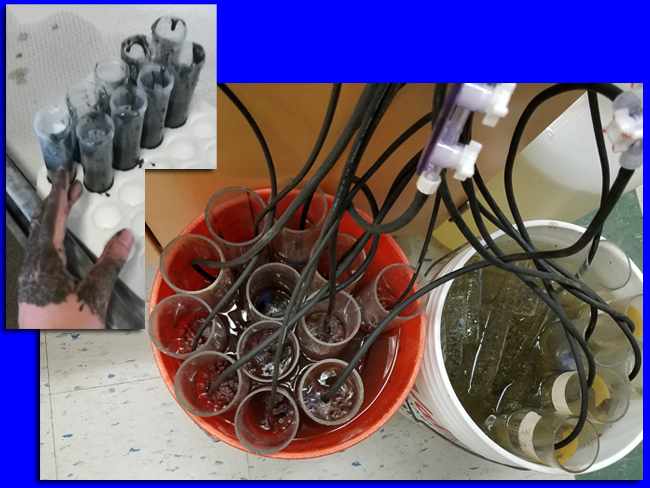
Scientists are preparing these small sediment cores for experiments that will measure the rate of nitrogen mineralization or turnover; (Inset) Syringe cores of sediment collected from the Western Long Island Sound will be used to measure the amount of nitrogen in sediments. Credit: Craig Tobias, University of Connecticut
“Tremendous progress has been made in reducing the nutrient loading that was the primary cause of Long Island Sound eutrophication,” said Altabet. “Research such as my own funded by the Long Island Sound Study is not only critical for charting the expected recovery of the Sound but also for guiding any additional measures that may need to be taken.”
Given that large amounts of nitrogen are stored in the Sound’s sediments, it will likely take many years to be removed by natural processes from the system.
Sediment Nutrient Cycling
In work led by Robinson Fulweiler (Boston University), researchers wanted to study the downward flow of organic matter from the top of the water column to the sediments on the bottom. In particular, they wanted to study how these sediments naturally remove nitrogen from the environment through microbial processes.
Technically speaking, the euphotic zone is the uppermost layer of the ocean and the one that receives sunlight; thus, it is the layer where organisms can generate energy by photosynthesis. It is from this layer where organic matter is produced by phytoplankton. When it settles to the sediment, it fuels microbial life there.
From the outset, scientists knew very little about the removal of nitrogen in the sediments of Long Island Sound. Fulweiler and her team measured how much nitrogen was being removed from stations across the Sound. They found the rates of nitrogen removal, or denitrification, did not differ much between sites.
“One of our primary research goals was to quantify how the sediments in the main basin of Long Island Sound remove nitrogen via the microbial process of denitrification,” said Fulweiler. “You can think of denitrification as a natural filtering process that can help improve water quality. We found that the sediments can remove about 10% of the total nitrogen entering Long Island Sound. This might not sound like a lot, yet when it comes to nitrogen, every bit we remove counts.”
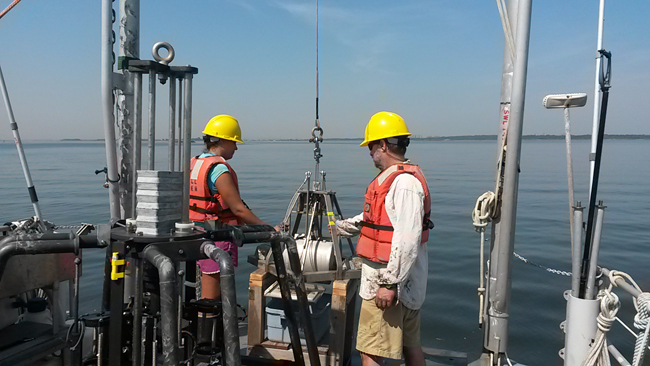
Scientist Craig Tobias and technician Alia Al-Haj tend to the Smith-MacIntyre Grab sampler, with the multi-corer nearby and ready to go. The Tobias and Fulweiler sediment collections were done concurrently with UCONN vessels and equipment. This was done on the R/V Lowell Weicker. Credit: Craig Tobias, University of Connecticut
Scientists gathered sediment cores from five locations representing different environmental conditions in the estuary. They found reduced sediment oxygen demand and ammonium fluxes, in fact 50 percent lower, similar to studies from other nearby coastal areas. These findings may reflect warming temperatures, reduced wind speed, or reduced nitrogen loading through improved management of WWTPs.
This study gives us more detail about how nitrogen is transferred around the Sound, and how it might be removed—or temporarily locked away—by natural processes.
Nitrogen Loss and Recycling
Craig Tobias (University of Connecticut) and his team of researchers also wanted to measure nitrogen removal rates from the sound’s sediments. But they took a more process-oriented approach, focusing on key chemical reactions that could either recycle or remove nitrogen from the waters.
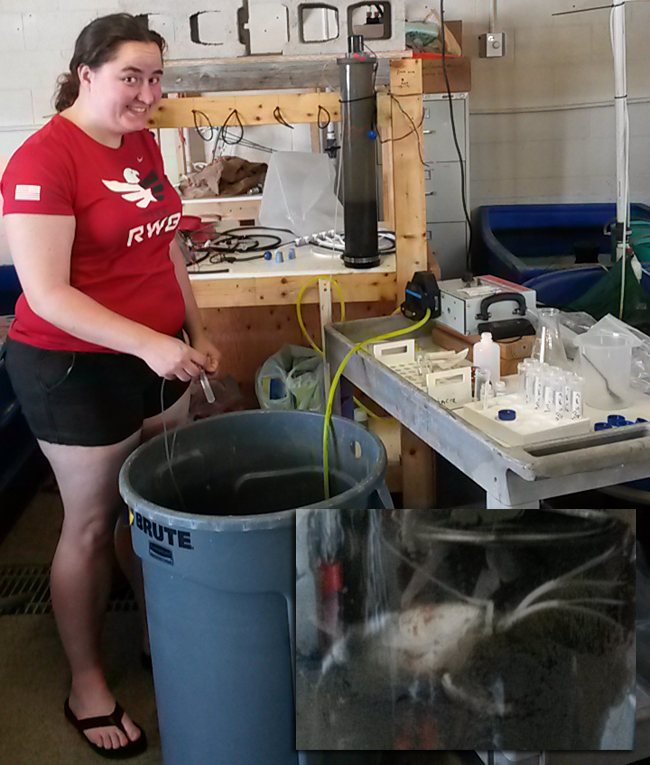
Veronica Rollinson, a technician at the University of Connecticut, samples and processes the core after incubation in order to measure denitrification and sediment water nutrient exchange; (Inset) A hitchhiker waits in one of the large cores. Collected from just outside hypoxic zone where there was abundant burrowing sediment infauna, this burrowing shrimp is probably a mantis shrimp. Credit: Craig Tobias, University of Connecticut
“If we want to build ecosystem models that accurately predict the sound’s future health, we need a solid understanding of the different processes that affect nitrogen recycling and removal,” said Tobias.
He and his team worked with the Altabet and Fulweiler teams, coordinating the effort to sample water and sediment at five stations in the Sound along the east-west axis.
Researchers knew, from previous research by Altabet and and Johan C. Varekamp (Wesleyan University), that significant nitrogen quantities, released by humans, remained in the Sound’s sediments. They would continue to be released back into the water column for some time to come.
Taken together, the teams’ results help us understand how much and how quickly nitrogen can be returned to the water from sediment. Their findings will help guide model preparation.
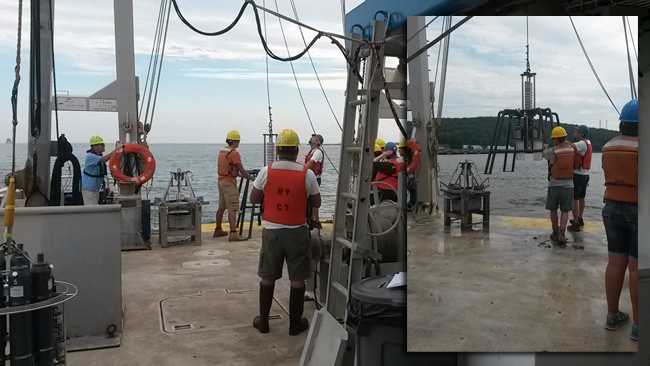
Scientists deploy a multi-corer off the R/V Connecticut for SONE and denitrification measurements; (Inset) Next to the multi-corer is a Smith-McIntyre Grab sampler, used to collect sediments that are later measured for nitrogen inventory and nitrogen turnover rates. Credit: Craig Tobias, University of Connecticut
Sediments are both a source and a sink for nitrogen to the Sound. They leak nitrogen back to the overlying water, but they are also important sites for reactions, specifically denitrification, that remove nitrogen. Scientists expect over time the balance will shift more towards nitrogen removal as landside nitrogen inputs decrease and the microbes work their way through the accumulated nitrogen inventory.
Scientists at this point are collecting data to inform models about nitrogen loading in the Sound. These models could help predict future nitrogen loading limits and hypoxia (oxygen deprivation) events. Their aim is to set reasonable goals and limits for hypoxia reductions.
Sediments act as a buffer, reducing about half of that nitrogen return to the overlying water. The mud and sand on the bottom is equally important as flushing for nitrogen removal.
Oxygen consumption by sediments is not the principal cause of hypoxia in any given year. But sediment nitrogen release represents another nitrogen source that ultimately helps fuel seasonal hypoxia events.
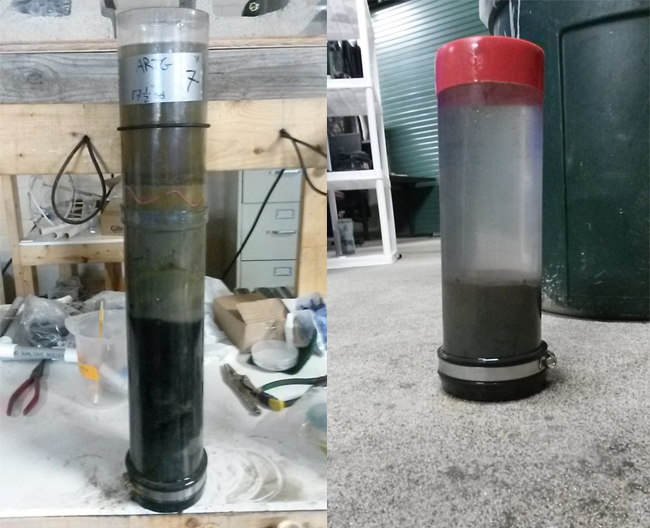
Good examples of incubation core samples, both of which were collected in Long Island Sound with the multi-corer and later incubated for SONE and denitrification measurements. (At Right) This sample was drawn from the ARTG station, a buoy for collecting water quality data on the edge of one of a seasonal hypoxic zone; (At Left) Note the clear sediment-water interface of this sample, which was collected from the Sound's eastern portion. Credit: Craig Tobias, University of Connecticut
Sea Level Rise and Wetland Vegetation
Coastal marshes are migrating inland. In many cases, they’re moving higher up in elevation—or elsewhere. They’re not predictably staying in place at the water’s edge, or between roads and bridges, as we expect them to.
Or they are disappearing.
It’s happening to such an extent that scientists have developed a model called SLAMM (sea level affecting marsh migration) to project how different levels of sea level rise might alter these vital salt marshes.
Beth Lawrence (University of Connecticut) and her team of researchers wanted to know how sea level rise and tidal restoration might alter the ability of coastal marshes to sequester carbon and remove nitrogen.
Researchers set up a field survey across 20 salt marshes to investigate how plant composition and management activities such as tidal restoration altered carbon and nitrogen processes underlying key ecosystem services. Their results suggest what might happen to the broader region as vegetation shifts in response to sea level rise, coastal development, and ecosystem management.
Scientists looked at different zones where one of three types of vegetation was dominant: Spartina alterniflora, Spartina patens, and Phragmites australis. They also examined sites that had a legacy of tidal restoration and compared them to reference sites that had not been previously restricted nor restored.
It turns out that the vegetation zone was a better predictor of marsh function than restoration activities. Dominant plants often reflect the actual water depth and salinity of the marshes. The type of vegetation can even predict microbial respiration and denitrification rates. This could be useful for quickly identifying how marshes function in future studies. In addition, changes in vegetation zones can serve as landscape-scale predictors for rapid changes occurring in salt marshes.
To disentangle the effects of vegetation, soils, and hydrology on carbon and nitrogen cycling, they conducted a type of study called a “marsh organ experiment.” By setting up PVC pipes of different heights within a tidal creek and planting them with marsh vegetation, they could test how different flooding frequencies altered plant biomass and microbial activity.
They found that carbon-based microbial processes were more greatly affected by the type of plant in the experiment than by the level of water.
Thus, the type of plant present in a natural setting is a quick guide to rates of carbon sequestration and nitrogen removal.
Furthermore, any changes to the vegetation of coastal wetlands affect their ability to carry out important functions like nitrogen removal and carbon storage.
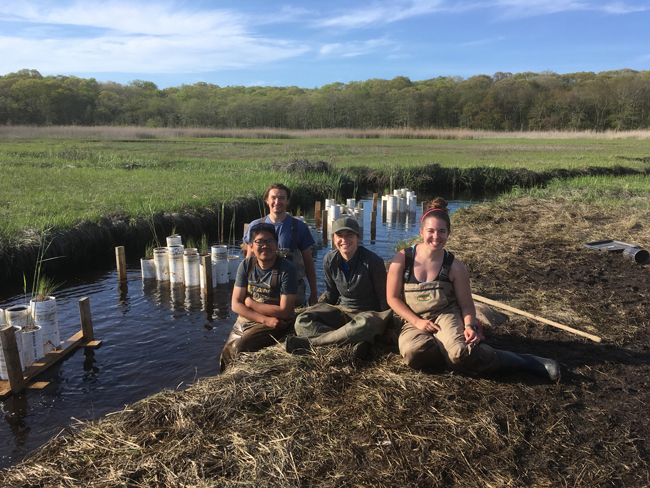
Students associated with the Long Island Sound Study pose in front of the “marsh organ” experiment. The PVC pipes are planted with marsh vegetation and cut to different lengths to simulate varied water levels. Credit: Beth Lawrence, University of Connecticut
Water Beneath the Surface
We often think that rivers are the primary routes for water from land to enter the sea. But water beneath the surface is important, too.
Submarine groundwater discharge (SGD) is an important source of freshwater and nutrients into Long Island Sound. Studies that have looked at nitrate and nitrite concentrations in SGD show that this flux is as great as or greater than that of surface runoff. Possible sources of nitrogen to SGD have overlapping nitrogen and oxygen isotope signatures, making it impossible to determine where the nitrogen comes from.
In this study conducted by Troy Rasbury, Henry Bokuniewicz, and J. Kirk Cochran, (Stony Brook University) boron stable isotopes were used to fingerprint sources of nitrogen at Callahans Beach and Iron Pier Beach. These sites were chosen because they are adjacent to different land use practices. Callahans Beach is down gradient from a medium density residential area with a golf course. Iron Pier Beach is down gradient from agriculture (vineyards and sod grass farms). While nitrogen and oxygen isotopes of nitrate overlapped between these studies, boron isotopes are distinct.
They successfully used boron isotopes as a compliment to nitrogen and oxygen stable isotopes to investigate the human-caused sources of nitrogen contamination in groundwater.
However, high boron concentrations in seawater may make it difficult to separate and identify its sources. They believe adding tests for pharmaceutical presence in water may help to identify human-sourced nitrates.
Nutrient and Carbon Transfer
A team led by Michael Whitney (University of Connecticut) wanted to understand the relationship between how much nitrogen, phosphorous, and carbon were present in the Sound, as well as how it was being transferred between different tributary coastal rivers and parts of the estuary.
Researchers studied the levels of nitrogen, phosphorous, and carbon in across-estuary sections in the Sound. They were particularly interested to see how nitrogen transfer and presence has changed given the large regulated reductions in nitrogen sent into the waters from WWTPs.
They wanted to determine the extent each basin (eastern, central, and western) is net heterotrophic, meaning nitrogen and carbon are required for life’s processes, indicating eutrophication, when water becomes enriched with dissolved nutrients that stimulate growth of aquatic plant life. Think: the birth of harmful algal blooms.
Investigators hypothesized that rivers would transport the highest concentrations of nutrients into the western Sound. The western Sound would become a net carbon “sink” in the summer, with a high nitrogen and phosphorous presence. Throughout the spring and summer, the eastern and central Sound would remain net autotrophic, requiring only carbon dioxide or carbonates as a source of carbon and a simple inorganic nitrogen compound for metabolic synthesis.
They conducted four field studies in the Sound, collecting carbon and nutrient samples, along with details about the water’s temperature and salinity.
Whitney and his team built models of both atmospheric and riverine deposition of nitrogen into the sound for the time period from 1994 to 2016. They used atmospheric data from the National Atmospheric Deposition Program.
Through this work, researchers established “budgets” for carbon and nitrogen in the Long Island Sound and its regions. These counts are helpful in determining how these elements and nutrients might interact with others, and impact our environment.
Water quality issues fundamentally depend on the dynamic interaction between quantities of nutrients, carbon, and freshwater. Now that these counts have been more accurately obtained, other parts of the equation can more easily be determined.
Although transfers of nitrogen between regions of the Sound are small, and reductions of nitrogen from WWTPs have improved conditions, there still is some transport of nitrogen from the west, the urbanized area, to the east.
These findings are particularly useful for scientists modeling how the delicate chemical balance in the water might continue to affect all life in the region. It’s also important for environmental officials and policymakers, as, according to the researchers, we will, as a society, need to keep making improvements in nitrogen reductions, especially in a warming climate scenario.
More Info: Long Island Sound Study
Long Island Sound is one of the 28 nationally designated estuaries under the National Estuary Program (NEP), which was established by Congress in 1987 to improve the quality of Long Island Sound and other places where rivers meet the sea.
The Long Island Sound Study is a cooperative effort sponsored by the Environmental Protection Agency and the states of Connecticut and New York to restore and protect the Sound and its ecosystems. The restoration work is guided by a Comprehensive Conservation and Management Plan under four themes: Clean Waters and Healthy Watersheds; Thriving Habitats and Abundant Wildlife; Sustainable and Resilient Communities; and Sound Science and Management.
For more on what you can do to make a difference, click over to the "Get Involved" or "Stewardship" sections of the Long Island Sound Study's website. News on the Long Island Sound Study can also be found in New York Sea Grant's related archives.
If you would like to receive Long Island Sound Study's newsletter, please visit their site's homepage and sign up for the "e-news/print newsletter" under the "Stay Connected" box.
More Info: New York Sea Grant
New York Sea Grant (NYSG), a cooperative program of Cornell University
and the State University of New York (SUNY), is one of 34 university-based
programs under the National Oceanic and Atmospheric Administration’s
National Sea Grant College Program.
Since 1971, NYSG has represented a statewide network of integrated
research, education and extension services promoting coastal community
economic vitality, environmental sustainability and citizen awareness
and understanding about the State’s marine and Great Lakes resources.
Through NYSG’s efforts, the combined talents of university scientists
and extension specialists help develop and transfer science-based
information to many coastal user groups—businesses and industries,
federal, state and local government decision-makers and agency managers,
educators, the media and the interested public.
The program maintains Great Lakes offices at Cornell University, University at Buffalo, SUNY Oswego and the Wayne County Cooperative Extension office
in Newark. In the State's marine waters, NYSG has offices at Stony Brook
University in Long Island, Brooklyn College and Cornell Cooperative
Extension in NYC and Elmsford and Kingston in the Hudson Valley.
For updates on Sea Grant activities: www.nyseagrant.org has RSS, Facebook, Twitter, Instagram, and YouTube links. NYSG offers a free e-list sign up via www.nyseagrant.org/nycoastlines for its flagship publication, NY Coastlines/Currents, which is published quarterly.